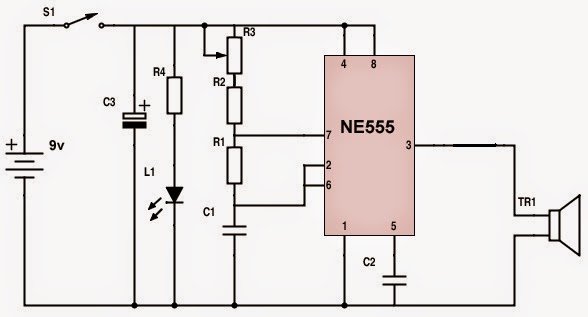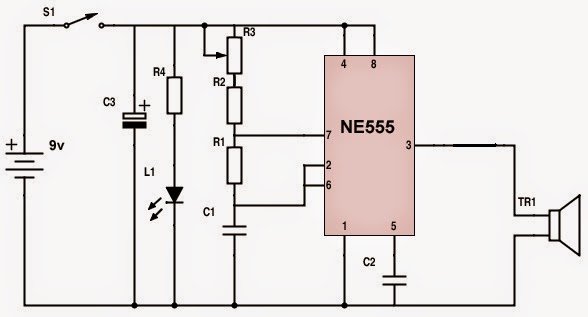This ultrasonic remote control circuit can be used to switch and control any appliance ON/OFF through a relay in the receiver circuit.
Written by: S.S. Kopparthy
Using Ultrasonic Waves
This circuit is a different one that uses ultrasonic sound waves whose frequency ranges from 40 KHz to 50 KHz.
These waves can’t be heard by humans as the hearing range of humans limited to roughly 20 KHz only. These waves require air medium to travel unlike infrared waves which are mostly used in remote controls.

The proposed ultrasonic remote control circuit uses ultrasonic transducers to produce and receive the ultrasonic signals.
Ultrasonic transducers are used in measuring the distance of an object and various other applications. In this circuit, we use them for a different purpose of making a remote controlled relay.
Receiver Circuit

Transmitter Circuit

This project consists of two parts i.e., ultrasonic transmitter circuit and ultrasonic receiver circuit.
The transmitter circuit consists of a 555 timer IC which is the heart of the circuit. Here, the 555 timer is used in astable multi vibrator mode. It could oscillate at a frequency of 40 - 50 KHz.
The ultrasonic transducer is used to transmit this frequency in the form of ultrasonic waves. A 9v battery can be used to power the transmitter circuit. The variable resistor R3 (in transmitter circuit) can be used to adjust the frequency.
The Receiver Circuit
The receiver circuit consists of two important stages for the processing of the ultrasonic waves received by the receiving transducer.
The first stage is a rectifier which amplifies the signals with the help of the transistors Q1 and Q2.
The rectified and filtered DC is fed to the inverting pin of the operational amplifier CA3140. The inverted output is used to bias the transistor Q3 which energizes the relay and there goes the second stage.
The preset resistor R2( in receiver circuit) can be used to adjust the sensitivity of the circuit.
You can use a 9v SMPS power supply to power the receiver circuit.
The receiver circuit should always remain ON and a push-to-on switch can be used in the transmitting circuit to be used as a remote.
Assemble the circuits on general purpose PCB’s. You can enclose the transmitter circuit in a suitable casing and the transducer, push-to-on switch and LED should be outside of the casing.
Ultrasonic waves are directional in nature and hence, you should direct the waves straight onto the receiving transducer for the relay to activate.
Parts List
- Transmitter circuit:
- R1 – 18K,
- R2 – 10K,
- R3 – 5K variable resistor,
- R4 – 1K,
- C1 – 680pf,
- C2 – 0.01µf,
- C3 – 100µf, 25v,
- L1 – green LED,
- TR1 – ultrasonic transmitter,
- S1 – push-to-on switch,
- Receiver circuit:
- R1 – 10K,
- R2 – 5K variable resistor,
- R3- 10K,
- R4 – 15K,
- R5 – 100K,
- R6 – 10K,
- R7 – 4.7K,
- R8 – 15K,
- R9 – 10K,
- R10 – 12K,
- R11 – 390K,
- R12 – 470K,
- R13 – 27K,
- R14 – 1K,
- C1 – 0.56µf,
- C2 – 0.1µf,
- C3 – 0.22µf,
- C4 – 10µf, 25v,
- D1, D2 – 1N4148,
- D3 – 1N4007,
- Q1, Q2 – BC 548,
- Q3 – BC 558,
- Q4 – SL 100,
- RY1 – 9v relay,
- RX1 – ultrasonic transmitter.
